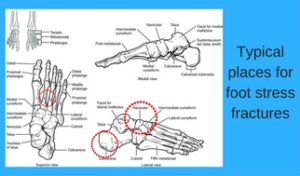This week we are going to talk about stress fractures. A stress fracture is not what happens this time of year to your sense of humor. A stress fracture is a small crack in a foot bone or shin bone. It is an overuse injury. While a broken bone is usually due to an event that causes the bone to break like a fall or other accident, a stress fracture occurs because the muscle around the bone is tired from being used too much and it does not support the bone in the usual manner. This can happen in sports like running and basketball when the foot or shin is exposed to repeated pounding.
Exposed to repeated stress – what does that mean?
There are several ways that your foot can be exposed to overuse stress. One way is if you suddenly increase your workout. The repeated demands suddenly escalating either by increasing duration or frequency of exercise can cause the muscles to become strained and not support the bones of the foot the way thy normally do. When this happens, the bone can develop small cracks.
If your shoes are worn out or too stiff, they can also lead to you having problems with a stress fracture. Also, some people find that going from one surface to another – like going from an indoor surface to and outdoor track can cause problems. Just remember when you change your environment, your muscles need to have time to adjust to the change.
Also, those who just start and exercise program are at risk if they start too fast rather than letting their endurance build.
What bones are susceptible to stress fractures?
The bones in the foot most susceptible to stress fractures are the following:
1. The second and third metatarsals of the foot (the long bones in the middle of the foot that lead to the second and third toes)
2. The heel
3. The fibula (the outer bone in the lower leg)
How do I know if I have a stress fracture?
The first indication might be that you start to have pain in your foot while you are exercising but it goes away when you rest. If you ignore it, the pain will start to be constant – even when you are not exercising. It may be that your foot is tender to the touch at the point of the stress fracture or that there is bruising at the fracture point.
There is no way for you to tell if you have a stress fracture if you don’t go to see your friendly local podiatrist. The doctor will ask questions and then look at your foot. You will probably have an x-ray to show any cracks in the bones. But stress fractures are difficult to see on x-rays. Your doctor may want you to have an MRI to really see if there is a fracture.
Okay, so I have a stress fracture – I want to get back to exercising. How fast can we fix this?
The first thing necessary to repair the fracture is rest. Yes, I know that is the last thing on your agenda but if you don’t give it time to heal then you can do more damage. (Think having to have surgery to pin the bone back together.) Depending upon the severity of the stress fracture and its location, your doctor may want you to wear a boot for a period so that the bone can heal. In some cases, you may need to stay off the foot completely and need to use crutches. Your doctor will give you instructions for what is needed to get your foot healed.
Remember – when you go back to exercising you will need to start slowly and build up your exercise program over time so that you don’t re-injure yourself.


